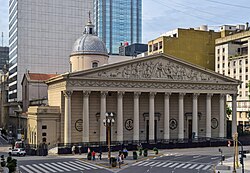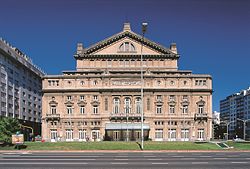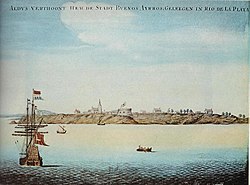Buenos Aires
Buenos Aires is the capital and largest city in the South American country of Argentina. It has its own executive, legislative and judicial powers. It is in the central-eastern region of the country, on the southern shore of the Río de la Plata, in the Pampas region. The city was ceded in 1880 by the Province of Buenos Aires to be the federal capital of the country. It is the "main capital", along with 24 alternate capitals, because of the constitutional reform of 1994. Buenos Aires city is also known as Capital Federal to differentiate the city from the Buenos Aires Province. Until 1994 Buenos Aires city was under the presidential government, but after a constitutional reform in that year, the city became self-governed, allowing citizens to elect their city authorities.
| Ciudad Autónoma de Buenos Aires Buenos Aires Ciudad | |
|
| |
 Location in Argentina | |
| Coordinates: 34°36′12″S 58°22′54″W / 34.60333°S 58.38167°WCoordinates: 34°36′12″S 58°22′54″W / 34.60333°S 58.38167°W | |
| Country | Argentina |
| Established | 1536, 1580 |
| Government | |
| • Type | Autonomous city |
| • Chief of Government | Jorge Macri |
| Area | |
| • Autonomous City | 203 km2 (78.5 sq mi) |
| • Land | 203 km2 (78.5 sq mi) |
| • Metro | 4,758 km2 (1,837 sq mi) |
| Elevation | 25 m (82 ft) |
| Population (2010 census.)[3] | |
| • Autonomous City | 2,890,151 |
| • Rank | 4th |
| • Density | 14,240/km2 (36,817/sq mi) |
| • Metro | 12,801,364 |
| Time zone | UTC−3 (ART) |
| HDI (2010) | 0.953 – Very High[4] |
| Website | www |
Population
3,040,000 people live in Buenos Aires. Spanish is the main language, but English is widely spoken and understood well. Italian is also widespread.
Climate
Buenos Aires has a humid subtropical climate (Köppen climate classification: Cfa). The average temperature is 17 °C. During the 20th century the temperature went up because of the urbanization. Rainfall is 1222.6 mm. per year. Summers are hot and humid. Winters are mild, the highest medium temperature is 13.7 °C during this season. Temperature rarely reaches 0 °C or below. Fog is frequent. Snow is extremely rare, and falls once or twice in a century.
Snow is very rare in the city: the last snowfall happened on 9 July 2007 when, during the coldest winter in Argentina in almost 30 years, severe snowfalls and blizzards hit the country. It was the first major snowfall in the city in 89 years.[5][6]
| Climate data for Buenos Aires Central Observatory, located in Villa Ortúzar (1981–2010, extremes 1906–present) | |||||||||||||
|---|---|---|---|---|---|---|---|---|---|---|---|---|---|
| Month | Jan | Feb | Mar | Apr | May | Jun | Jul | Aug | Sep | Oct | Nov | Dec | Year |
| Record high °C (°F) | 43.3 (109.9) |
38.7 (101.7) |
37.9 (100.2) |
36.0 (96.8) |
31.6 (88.9) |
28.5 (83.3) |
30.2 (86.4) |
34.4 (93.9) |
35.3 (95.5) |
35.6 (96.1) |
36.8 (98.2) |
40.5 (104.9) |
43.3 (109.9) |
| Average high °C (°F) | 30.1 (86.2) |
28.6 (83.5) |
26.8 (80.2) |
22.9 (73.2) |
19.3 (66.7) |
16.0 (60.8) |
15.4 (59.7) |
17.7 (63.9) |
19.3 (66.7) |
22.6 (72.7) |
25.6 (78.1) |
28.5 (83.3) |
22.7 (72.9) |
| Daily mean °C (°F) | 24.9 (76.8) |
23.6 (74.5) |
21.9 (71.4) |
17.9 (64.2) |
14.5 (58.1) |
11.7 (53.1) |
11.0 (51.8) |
12.8 (55) |
14.6 (58.3) |
17.8 (64) |
20.7 (69.3) |
23.3 (73.9) |
17.9 (64.2) |
| Average low °C (°F) | 20.1 (68.2) |
19.3 (66.7) |
17.7 (63.9) |
13.8 (56.8) |
10.7 (51.3) |
8.0 (46.4) |
7.4 (45.3) |
8.8 (47.8) |
10.3 (50.5) |
13.3 (55.9) |
15.9 (60.6) |
18.4 (65.1) |
13.6 (56.5) |
| Record low °C (°F) | 5.9 (42.6) |
4.2 (39.6) |
2.8 (37) |
−2.3 (27.9) |
−4.0 (25) |
−5.3 (22.5) |
−5.4 (22.3) |
−4.0 (25) |
−2.4 (27.7) |
−2.0 (28) |
1.6 (34.9) |
3.7 (38.7) |
−5.4 (22.3) |
| Precipitation mm (inches) | 138.8 (5.465) |
127.1 (5.004) |
140.1 (5.516) |
119.0 (4.685) |
92.3 (3.634) |
58.8 (2.315) |
60.6 (2.386) |
64.2 (2.528) |
72.0 (2.835) |
127.2 (5.008) |
117.3 (4.618) |
118.9 (4.681) |
1,236.3 (48.673) |
| % Humidity | 64 | 68 | 72 | 76 | 77 | 79 | 79 | 74 | 70 | 69 | 66 | 63 | 71 |
| Avg. precipitation days (≥ 0.1 mm) | 9 | 8 | 9 | 9 | 7 | 7 | 7 | 7 | 7 | 10 | 10 | 9 | 99 |
| Source #1: Servicio Meteorológico Nacional[7] | |||||||||||||
| Source #2: NOAA (humidity, 1961–1990)[8] | |||||||||||||
Neighborhoods
Buenos Aires is divided into 48 neighborhoods. Most populated areas are:
- Palermo: Located in the northeast of the city, it also is the largest neighborhood in Buenos Aires. Some parts of Palermo are highly touristic: Bosques de Palermo (Palermo Woods), Palermo Soho, Palermo Hollywood
- Caballito: This mostly residential neighborhood is located in the geographical centre of the city.
- Recoleta: Recoleta is one of the most wealthy neighborhoods in Buenos Aires. Recoleta Cemetery is located there.
Tourism
Buenos Aires is the most visited city in South America.[9] The most touristic areas are the historical center, Palermo, Recoleta and San Telmo. In 2005, because of the city's architecture and fashion design culture, Buenos Aires was appointed as the first UNESCO City of Design,[10] and received this title once again in 2007.[11]
- Historical Center / Plaza de Mayo: It is the historical place of the foundation of the city. On Plaza de Mayo, many interesting buildings can be found : Cabildo (where the colonial government was), Cathedral, Casa Rosada (current Government Palace).
- San Telmo is one of the most ancient neighborhoods in Buenos Aires. It used to be a very expensive area. But in the 18th Century, an epidemic made people move to Recoleta area, farther from the river.
- Recoleta: In this neighborhood, there are many beautiful Palaces from the 19th Century. Tourists also visit Recoleta Cemetery where many political figures are buried. One famous person buried in Recoleta Cemetery is political woman Eva Perón.
- Palermo: Palermo is divided in several sub-areas. Palermo Soho is full of designers and clothing shops. Palermo Hollywood is the gastronomical heart of Buenos Aires.
- Boedo: Classical and very interesting tango and literature historical district. A remarkable episode in the Argentine literature's history is the social and literary dialogue between the Florida Group, named this way because its members used to meet up at the Richmond Cafeteria at Florida street and publish their work in the Martin Fierro magazine, like Jorge Luis Borges, Leopoldo Marechal, Antonio Berni (artist), among others, versus the Boedo Group of Roberto Arlt, Manzi and other writers and artists. They used to meet together at the Japanese Cafe and published their works with the Editorial Claridad, with both the cafe and the publisher located at the Boedo Avenue.
Wikimania
Buenos Aires Media
Juan de Garay founding Buenos Aires in 1580. The initial settlement, founded by Pedro de Mendoza, had been abandoned since 1542.
Emeric Essex Vidal, General view of Buenos Ayres from the Plaza de Toros, 1820. In this area now lies the Plaza San Martín.
Impression of the Buenos Aires Cathedral by Carlos Pellegrini, 1829
View of the Avenida de Mayo in 1915
LZ 127 Graf Zeppelin flying near the Barolo Palace in Buenos Aires on June 30, 1934.
9 de Julio Avenue, 1986
Catalinas Norte is an important business complex composed of nineteen commercial office buildings and occupied by numerous leading Argentine companies, foreign subsidiaries, and diplomatic offices. It is located in the Buenos Aires Central Business District.
Satellite view of the Greater Buenos Aires area, and the Río de la Plata
References
- ↑ Owens, Mitchell. "Travel+Leisure: Buenos Aires Reinventing Itself". Travelandleisure.com. Retrieved 2 May 2012.
- ↑ "Sitio oficial de turismo de la Ciudad de Buenos Aires". Bue.gov.ar. Archived from the original on 15 April 2012. Retrieved 2 May 2012.
- ↑ "Argentina: Censo2010". Archived from the original on 20 December 2010. Retrieved 25 February 2011.
- ↑ "Reports | National Reports | Latin America and the Caribbean | Argentina | Human Development Reports (HDR) | United Nations Development Programme (UNDP)". Hdr.undp.org. Archived from the original on 2013-04-26. Retrieved 2013-03-12.
- ↑ "Buenos Aires sees rare snowfall". BBC News. 10 July 2007. http://news.bbc.co.uk/1/hi/world/americas/6286484.stm. Retrieved 24 January 2008.
- ↑ "Buenos Aires gets first snow since 1918". USA Today. 9 July 2007. https://www.usatoday.com/news/world/2007-07-09-argentina-snow_N.htm. Retrieved 24 January 2008.
- ↑ "Caracteristicas Climaticas de la Ciudad de Buenos Aires" (in Spanish). Servicio Meteorológico Nacional. Retrieved 18 January 2017.
{{cite web}}: CS1 maint: unrecognized language (link) - ↑ "Buenos Aires Climate Normals 1961–1990". National Oceanic and Atmospheric Administration. Retrieved 3 January 2016.
- ↑ "México DF, Buenos Aires y San Pablo, los destinos turísticos favoritos - América". Archived from the original on 2014-10-10. Retrieved 2013-12-17.
- ↑ "Buenos Aires, Argentina appointed UNESCO City of Design". Portal.unesco.org. Archived from the original on 17 July 2012. Retrieved 2 May 2012.
- ↑ "Buenos Aires: UNESCO City of Design" (PDF). Archived (PDF) from the original on 7 June 2012. Retrieved 2 May 2012.
Other websites
| Wikimedia Commons has media related to Lua error in Module:Commons_link at line 62: attempt to index field 'wikibase' (a nil value).. |
- Google Maps Satellite city View
- Palo Santo Buenos Aires Guide Archived 2019-12-30 at the Wayback Machine
- Buenos Aires Travel Guide Archived 2006-10-05 at the Wayback Machine
- english.buenosaires.com - Tourism Portal[dead link]
- Official Tourism Website (English, Spanish, Portuguese and guides in ten different languages including Chinese, Japanese, French, German, Italian, etc.) Archived 2006-07-20 at the Wayback Machine
Online newspapers
- The Buenos Aires Herald Online edition of a local English language newspaper
- La Nación
- Infobae
- La Prensa
- Clarín
| Provinces of Argentina | |
|---|---|
| Buenos Aires | Buenos Aires Province | Catamarca | Chaco | Chubut | Córdoba | Corrientes | Entre Ríos | Formosa | Jujuy | La Pampa | La Rioja | Mendoza | Misiones | Neuquen | Río Negro | Salta | San Juan | San Luis | Santa Cruz | Santa Fe | Santiago del Estero | Tierra del Fuego, Antarctica, and South Atlantic Islands | Tucumán | |





















